Unleashing educational shift: Explore how technology revolutionized education, from virtual travel to interactive maps. A new era of learning awaits.
In today’s rapidly evolving digital landscape, technology has ushered in a paradigm shift in education. From traditional classroom settings to virtual learning environments, the effect of technology on education has been transformative. This article delves into how technology has revolutionized education, paving the way for improved learning experiences. With a special focus on maps, Google Street View, and traveling, we explore how these tools have expanded students’ horizons, fostered global awareness, and personalized learning. Moreover, technology has facilitated remote and distance learning, breaking down geographical barriers and providing access to education for diverse populations. Join us on a journey to discover how technology has changed education forever.
Enhancing Classroom Learning with Interactive Maps:
Gone are the days when students had to rely solely on textbooks and lectures to learn geographical concepts. With the emergence of digital maps, such as Google Maps, students can now embark on virtual journeys across the globe without leaving their classrooms. These interactive maps offer a rich and immersive learning experience, allowing students to explore different regions, landmarks, and cultural phenomena. By integrating maps into their lessons, teachers can foster a deeper understanding of geography, history, and social sciences, bringing the world into the classroom.
Expanding Horizons with Google Street View:
Imagine walking through the bustling streets of Paris, strolling along the Great Wall of China, or even investigating the depths of the Amazon rainforest, all from the comfort of your classroom. Google Street View has made these experiences possible, enabling students to visit iconic locations worldwide virtually. It has emerged as a groundbreaking technology that has revolutionized how we explore the world. With just a few clicks, students can embark on virtual travels to iconic destinations, immersing themselves in the sights and sounds of distant places. This technology allows educators to create virtual field trips involving students in diverse cultures, historical sites, and natural wonders. Such exciting experiences not only spark curiosity and ignite passion for learning but also foster a global perspective among students.
Connecting Classroom Learning with Real-World Travel:
While virtual experiences offer outstanding value, nothing compares to firsthand experiences and the thrill of exploring the world in person. With the help of technology, travel has become more accessible and efficient, encouraging educational institutions to integrate travel programs into their curricula. Field trips and study abroad opportunities provide students with the chance to witness history, culture, and natural wonders up close, forging lasting memories and deepening their understanding of various subjects. Technology promotes the planning and organization of these trips, ensuring a seamless and enriching experience for students.
Customizing Learning with Personalized Maps:
In addition to global exploration, technology empowers educators to create personalized learning experiences tailored to individual student requirements. Teachers can develop customized maps through digital mapping tools, emphasizing specific areas of interest or relevance to a particular lesson. Whether it’s planning the historical events of a specific region or tracking the migratory patterns of animals, personalized maps enable students to delve deeper into subjects, fostering critical thinking and analytical skills. Moreover, students can actively partake in the map creation process, encouraging teamwork and a sense of ownership over their learning.
Breaking Barriers and Promoting Inclusivity:
Technology has seriously contributed to breaking down barriers in education, particularly for learners with disabilities or limited access to traditional learning resources. Digital maps and virtual experiences offer visually impaired students the opportunity to explore the world through audio descriptions and tactile interfaces. Additionally, technology facilitates real-time translation, allowing students from diverse linguistic backgrounds to engage with educational content effectively. By leveraging technology in education, we foster a more inclusive and unbiased learning environment, ensuring every student can thrive.
Empowering Remote and Distance Learning:
Technology has been crucial in destroying geographical barriers and enabling remote and distance learning. With the advances in communication tools and online platforms, students and educators can connect and engage in learning regardless of physical location. This has proven highly beneficial for individuals who are unable to attend traditional brick-and-mortar institutions due to various reasons, such as health problems, work commitments, or living in remote areas. Online learning platforms, interactive video conferences, and collaborative digital tools have revolutionized education by providing access to quality education to a broader audience. Technology has allowed students to pursue degrees, certifications, and skill development programs from the comfort of their homes, fostering lifelong learning prospects for all.
As we reflect on the profound impact of technology on education, it is evident that the integration of maps, Google Street View, and travel has transformed how we learn and teach. These technological advancements, along with professional writing essay assistance like the one provided by https://ordertermpaper.net site, have enriched the educational experience, providing students with new perspectives, global awareness, and personalized learning opportunities. Through the seamless integration of technology and education, we equip future generations with the skills and knowledge needed to navigate an ever-evolving world.





Very cool this article, and I would like to express myself on this subject here.
Well, I think it’s cool when it comes to technology in favor of education, and I’ve been there.
I remember that my teachers used laptops to display the content through the projectors, in addition to us students copying the activities from there. But years ago, that was nearly impossible.
Where I live here in Paraná, the former governor’s management in relation to education (and the inclusion of technology in this context) was terrible, but from 2019, currently with Ratinho Junior (2019-current) it was a revolution that I have never I had seen, now Portuguese essays are done online, readings of books that were previously done in the library, now all on a single platform, distribution of netbooks for use in computer rooms, educational games for self-learning, among other things. No wonder that the state of Paraná leads first in public education in Brazil!
In addition to course, the use of Google Maps and Google Earth also allowed me and the public school students to learn more about the subject of the classes. I found it very interesting that Streetviewfun posted an article that talks well about this issue!
In fact, although I expressed what I lived here in the region, we have many places in the world where there is not even a quality education (I do not mean to have something technological only) and I hope that the rulers of each country can look at this situation and change as soon as possible, because only education can transform the world!